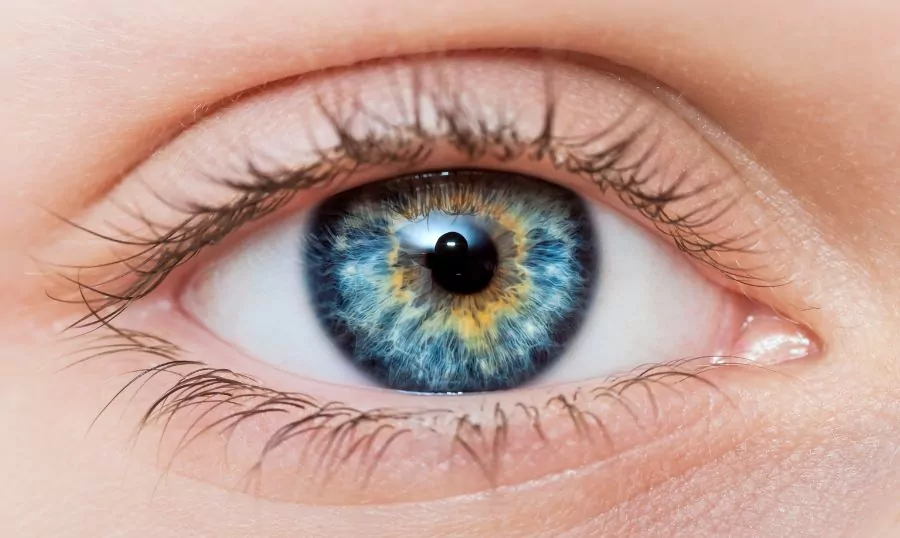The 5 Most Common Eye Injuries for Athletes
Sports and physical activities play a crucial role in maintaining a healthy lifestyle, but they also come with potential risks, including eye injuries

If you have blue eyes, you’re a member of an exclusive club – just 8-10% of the world’s population shares this eye colour. That’s probably because blue eyes emerged relatively recently on an evolutionary scale. A single human ancestor with a genetic mutation was the first to have blue eyes, and every blue-eyed person living is genetically linked to that person.
Fascinating, right? Here’s a look at more blue-eye facts.
Just like the sky, blue eyes don’t contain any blue pigment. Instead, the way they absorb and reflect light waves makes them look blue.
The iris – or the coloured part of the eye – has two layers. The back layer, the pigment epithelium, contains brown pigment in people of all eye colours. The front layer, called the stroma, is made up of overlapping fibres. In people with brown eyes, some of these cells contain brown pigment – also called melanin. In blue eyes, the cells have no pigment at all. These colourless fibres absorb longer wavelengths of light and reflect shorter wavelengths, making them look blue.
Melanin has a protective effect, shielding the eye from UV radiation and blue light. Because blue eyes contain less melanin, they can be more sensitive to light and susceptible to sun damage. If you have blue eyes, it’s a good idea to wear sunglasses with a high UV rating and minimise time in the sun.
According to research from the University of Copenhagen, all blue-eyed people will likely be descended from a single ancestor. While early humans all had brown eyes, the study found that the first person with blue eyes was born in Europe 6,000 to 10,000 years ago due to a genetic mutation.
The mutation occurs on the OCA2 gene, resulting in a genetic ‘switch’ that limits melanin production in the eye. As we’ve seen, less melanin changes the way light is reflected, making the eyes look blue. The research found that all blue-eyed people have the same mutation at the same ‘spot’ in their chromosomes, indicating that they inherited their blue eyes from the same person.
“We can conclude that all blue-eyed individuals are linked to the same ancestor. They have all inherited the same switch at the same spot in their DNA,” explains Hans Eiberg, associate professor in the Department of Cellular and Molecular Medicine at the University of Copenhagen.
Ever notice a blue-eyed newborn turning into a brown-eyed toddler? Human babies are born without their full complement of melanin, which is why skin, hair and eye colour can change after birth. Most Caucasian babies are born with blue eyes, but this can change as melanin production increases. In most cases, the eyes settle into their adult colour by the time a child is a year old.
A recent study suggests that people with blue eyes have a higher risk of developing alcohol dependency. The research, published in the American Journal of Medical Genetics, found that European Americans with blue eyes were up to 83% more likely to become dependent on alcohol than those with darker eye colours. This doesn’t mean that all blue-eyed people are destined to be alcoholics – it just suggests a correlation between gene sequences that determine eye colour and genes linked to alcohol issues.
If you took biology in high school, you may remember learning that blue eyes are a recessive trait, meaning that only blue-eyed parents could have blue-eyed children. In fact, in the past, eye colour was used as a paternity test based on those genetic assumptions.
We now know that eye colour genetics are far more complicated. Rather than being passed down as a single gene – brown, blue, hazel or green – eye colour is polygenic. This means it’s determined by the interaction of up to 16 genes. The structure of the iris can also make the eyes seem lighter or darker, making eye colour even more complicated.
Even if you and your partner have blue eyes, it’s impossible to predict your children’s eye colour accurately. A royal example: blue-eyed Prince William and green-eyed Kate Middleton have two sons with brown eyes and a daughter with blue eyes.
Blue eyes may be more susceptible to sun damage and light sensitivity, but all eyes need care. Blue, brown, green, or hazel, Auckland Eye can help.
Auckland Eye is the largest and most trusted eye care provider in New Zealand.
Book an appointment with us today at admin@aucklandeye.co.nz or call us on 0800 25 53 93.

Sports and physical activities play a crucial role in maintaining a healthy lifestyle, but they also come with potential risks, including eye injuries

For those leading an active lifestyle or engaged in sports, the significance of clear vision cannot be overstated.

Uncover the revolutionary technology behind LASIK that has empowered millions to enjoy clear vision without glasses.